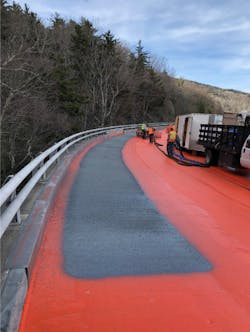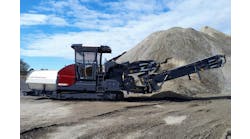The Blue Ridge Parkway revels in its new autumn shades of yellow, orange and red that follow the road’s meandering, peaceful curves. Quickly, the brisk fall weather turns to biting winter cold, and the skies shift from clear blues to darker greys. The landscape becomes stark, quiet and still as the Blue Ridge Mountains enter their winter slumber. Then, just as quickly, spring bellows forth, as vibrant shades of green paint the mountainsides and the sounds of life return to the landscape. There is beauty in the changing seasons, in watching these cycles end and begin anew. This cyclic beauty is readily abundant along the entire 469 miles of the Blue Ridge Parkway’s stunning views of the Appalachian Highlands.
Snaking around the Grandfather Mountain near Asheville, N.C., lies the Linn Cove Viaduct. This closing section of the Blue Ridge Parkway was completed in 1987 and links the Shenandoah National Park and Great Smoky Mountains National Park systems with terminus points in Asheville and Roanoke, Va. After 31 years of service, the asphalt roadway had reached the end of its life, and a series of preventative maintenance measures were taken to ensure this spectacular piece of infrastructure remains accessible to future generations of travelers hoping to experience the beauty and majesty of this unique area.
A viaduct can either be longer bridges or a series of connected bridges, especially over valleys and gorges, that typically carry road and railway traffic. Viaducts are used to connect two points of terrain at similar heights and are supported by arches of equal spans with top carrying surface. The Linn Cove Viaduct is considered a symbol of pride as it married engineering utility and protection of the surrounding fragile habitat.
When the viaduct was under construction, disturbance to the environment was limited to the founding and placement of seven permanent piers that help secure the viaduct while the remaining construction could be considered eco-friendly constructing in a top-down approach.
During the two months of the rehabilitation project, several items of work were completed including the replacement of the asphalt pavement and bridge joints, and repairs to the supporting structure, granite curb, railing, and drainage features. Additionally, the existing waterproofing under the asphalt pavement was replaced with a high-performance, spray-applied waterproofing system.
Waterproofing with asphalt pavement has a mixed history of success in the U.S. Due to a historical underperformance of traditional waterproofing systems such as rubberized asphalt and sheet membranes, the use of waterproofing-asphalt pavement assemblies on bridge decks began to fall out of favor with some agencies. These traditional systems were prone to failure (lack of adhesion, damage during construction and leaking), had limited service life (less than 25 years), and were typically removed when the asphalt pavement was replaced. Because asphalt is porous and can trap water, failure of the membrane accelerated the deterioration of the structure by allowing chloride-laden water into the bridge deck. In response, agencies began removing their asphalt overlays so they could more easily see deterioration of their bridge decks.
However, bare concrete decks are completely exposed to chlorides and other corrosive elements, have significantly rougher and louder driving surfaces, and have a shorter service life than those protected with an effective waterproofing system. High-performance spray-applied waterproofing systems address the performance issues agencies experienced in the past, offering significantly longer service life (designed to last the life of the structure), a completely seamless and monolithic membrane, and greatly enhanced durability. The inclusion of an asphalt pavement offers a smoother, quieter driving surface, and the enhanced durability of the membrane allows the pavement to be replaced without having to replace the underlying membrane. Asphalt pavement is cost-effective, easy to install, durable, and recyclable providing a low-cost solution at superior quality with limited disturbance to the existing site and surrounding environment.
As the successful use of spray-applied waterproofing is becoming more prevalent in the U.S., many agencies are beginning to consider the whole life cost of their structures, accounting for both original construction as well as the cost of future maintenance and traffic disruption to the traveling public, and are discovering that spray-applied waterproofing is an effective long-term deck protection strategy. Some agencies have gone a step further and are now using newer generation spray-applied waterproofing systems on all their bridges.
The waterproofing contractor Pine Waterproofing & Sealant Inc. selected the Bridge Preservation (BP) spray-applied waterproofing system for the project because of BP's extensive history of successful installations throughout North America, as well as the unique advantages the system provides, including rapid cure time irrespective of temperature, automated spray application, which increases the consistency and evenness of the spray application while limiting worker fatigue, and the bridge deck membrane’s ability to accept temporary vehicular traffic prior to paving operations (topcoat with aggregate broadcast). BP systems stay flexible over time and over a wide range of operating temperatures, and will not hydrolyze, leach, or degrade over time. The high-performance waterproofing system provides a superior solution for a superior site.
This project is exceptional because of the grandeur of its own history. Not only has it provided an engineering marvel the coexists with the surrounding environment, but it remains a vital section of the broader Blue Ridge Parkway. As of 2018, National Geographic released the most visited National Parks for 2017, and conquering in its grandiosity, the Great Smoky Mountains National Park continues to be the most visited national park in the nation. Its over 11 million visitors each year nearly doubles the Grand Canyon National Park at 6.2 million visitors, which holds the number two spot. Most visitors see the Great Smoky Mountains from a mountain-skimming scenic highway, known as the Blue Ridge Parkway, making it one of the most heavily traveled roads in America. The ability to complete the project with outstanding results presents a testament to the high-quality solutions provided by Bridge Preservation. Just as the seasons cycle showing different perspectives throughout the year, so do man-made infrastructure projects. The difference is in the lifespan of these cycles, and the Linn Cove Viaduct has entered a new spring.



